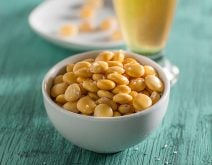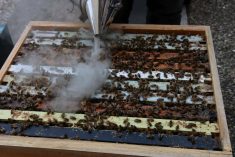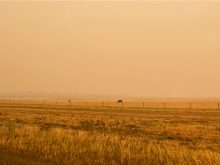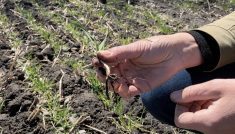There are many ways to reduce early season stress on emergence, starting with planting date,” says Aaron Miller, an agronomist with DuPont Pioneer.
Here are six.
1. Planting date
“While planting early offers potential benefits, it also presents some challenges,” says Aaron Miller.
“A well prepared seedbed along with the right temperature (close to 10 C) and adequate moisture are most important when determining when to plant,” says Miller. However, if soil conditions are too cold or wet for planting, crops potentially face more emergence stresses.
Read Also

Cancer agency reclassifies another herbicide ‘probably carcinogenic’
The WHO’s cancer research agency has now put atrazine, a herbicide well known to corn growers, in the same potential-hazard category where the agency put glyphosate.
A critical way to protect against stand and yield loss is to “choose a planting date based on soil conditions and weather outlook by monitoring soil temperature at planting depth, delaying planting until soils reach 10 C.”
If the near-term forecast predicts a warming trend, Miller said, “You could start planting when soil temperature is close to 5 C.”
On the other hand, if the near-term forecast predicts a cold spell, Miller advises, “Stop planting for a few days to allow emergence to begin at moderate temperatures.
“With lighter soils planted early, be aware of potential for large temperature swings that can affect emergence, especially if nighttime temperatures dip close to freezing.”
2. Planting conditions
“Planting when soils are too wet can lead to compaction and poor emergence,” says Miller. “Conversely, soils that are too dry can have spotty emergence, leading to poor emergence and an uneven plant stand.”
3. Residue spreading
When planting in a field with high amounts of residue, Miller advises harrowing or tillage to spread straw. “This will improve trash clearance and seed-to-soil contact.”
Miller says managing residue will speed up soil warming and drying during the critical planting season. “Well-drained, low-residue fields typically warm up faster and allow for more rapid emergence and seedling growth.”
“Pioneer research has documented that residue over seed furrow can reduce soil temperatures, leading to delayed emergence and possible stand loss.”
Residue can translate into additional challenges for crop emergence and homogeny.
Some of these challenges, according to Miller, are “uneven germination and emergence, the promotion of seedling disease by harbouring disease pathogens favoured by excess water and colder soils, and uneven planting depth and poor seed-to soil contact, leading to uneven emergence and possible appearance of runt plants.”
More from the Grainews website: Three good reasons to test seed lots now
4. Seed selection
When it comes to choosing hybrids, Miller advises selecting certified seed with high germination and stress-emergence scores. This will help reduce risks associated with planting in cold-stress conditions. “Selecting a hybrid with the right trait package for high-residue environments too is key.”
Pioneer assigns stress emergence scores to help farmers choose products for early planting or fields with a history of cold stress challenges.
“Choosing hybrids with higher scores for these traits helps reduce genetic vulnerability to stress brought on by cold soils and high residue environments.
5. Seed treatments
When it comes to planting early, Miller suggests considering seed treatment options.
“Early season insects are often a problem in early planting and high residue conditions — more so if seedlings are weakened by cold or overly wet soils.
“Insecticide seed treatments have proven very effective at protecting stands in stressful environments,” Miller says. “They protect against seedling disease by reducing insect feeding and depriving pathogens of points of entry.”
6. Rotation management
In the end, Miller says, “a good rotation remains one of the best ways to manage crop disease pressure.”
Rebeca Kuropatwa is a professional writer in Winnipeg, Man.















